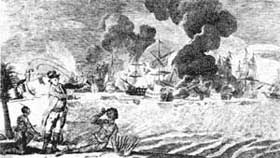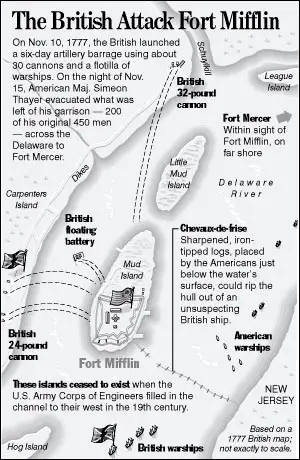The Battle of Fort Miffin (Second)
November 15, 1777 at Mud Island, Pennsylvania



|
|
| Strength |
Killed & Wounded |
Missing / Captured |
| 450 |
250
|
? |
| |
| Strength |
Killed |
Wounded |
Missing / Captured |
| 2,000+ |
13 |
24
|
? |
| | Conclusion: British Victory |
|
Cannons boom on the Delaware River. Hour after hour, day after day, British artillery on land and on ship have pounded Fort Mifflin, hunched over on its muddy little island in the river just off the Pennsylvania shore. Inside the fort, American soldiers - cold, wet, sleepless and hungry - hang on defiantly, keeping British ships from getting to Philadelphia with supplies badly needed by the redcoat army occupying the city.
The British have been trying for the better part of 2 months to break the American blockade of the river.
After the Fort Mercer fiasco, an impatient Howe ratcheted up the pressure on Fort Mifflin, the key to the defensive screen the Americans had thrown across the Delaware just south of Philadelphia. The British had been fbombarding Fort Mifflin since October 15.
On November 10, the British intensified their attack, beginning a round-the-clock bombardment. At times, the British fire was many as 1,000 cannonballs in 20 minutes. At the time, the fort itself is only partially completed when the siege began, making it difficult to defend.
After several days, the British batteries silenced nearly every piece of artillery at Fort Mifflin. "Our men were cut up like cornstalks... ," Joseph P. Martin recalled years later. "The whole area of the fort was as completely plowed as a field... . If ever destruction was complete, it was here." Off to the northwest of the city at Whitemarsh, Gen. George Washington and his ill-shod army could only wait helplessly, out of position to launch an attack that would break the siege.



The east and south walls, facing the river, are granite, but the north and west walls, facing the land, are palisades and packed dirt. After the British cannons battered the walls all day, the Americans would scramble to rebuild them at night. The Americans put up a valiant defense, even managing to silence a British battery, but they are outmanned and outgunned. British firepower turns the fort into a killing ground, with almost nowhere to hide.
On November 15, during the night, the American garrison bowed to the inevitable and abandoned Fort Mifflin, leaving the dead behind and the flag flying. Over half of the fort's American defenders were casualties. They "set fire to every thing that would burn, and then repaired immediately to the wharf where three bateaux were waiting to convey us across the river."
The siege of Fort Mifflin was over. Soon, Howe would be free to turn his attention once more to destroying Washington.
Across the river at Red Bank on the New Jersey side, Fort Mercer, the last American stronghold on the Delaware, hung on for another 5 days before Continental forces abandoned it on the night of November 21. A few small British ships arrive in Philadelphia the very next day, to be followed soon by other, larger vessels.
The British at last had their water route and a free flow of supplies to Philadelphia, but the stubborn American resistance had tied up the British for nearly 7 weeks. This allowed Washington to regroup after the hard fighting and marching of late summer and early fall.